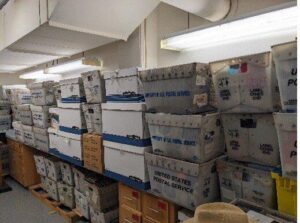This post is by Corey Halaychik, who is the Head of Content Management at The University of Texas at Austin Libraries and the Founder of The Library Collective, an independent nonprofit organization dedicated to education and innovation for better librarianship.
Make no mistake about it, Artificial Intelligence (AI) will replace some tasks and jobs performed by library workers. This shouldn’t cause panic; instead, it should be celebrated. AI can free library workers to do more important and meaningful work. Libraries should not use AI just because it’s trendy or because other places do. Instead, they should consider their unique situations, like skill levels, staffing, funding, and mission.
And while AI can be used in many parts of a library, libraries should be careful not to let it negatively impact their public services. Human interactions make libraries special to users and are important for building connections. Libraries should therefore avoid using AI where a “human touch” is needed or looks better.
Using AI to support teams like technical services, which don’t usually interact with the public, can be a better idea. This way, AI won’t reduce human interaction with users, and it can help these teams work more efficiently. This allows libraries to invest in people where it matters most and allow AI to handle routine jobs.
The University of Texas at Austin Libraries’ Content Management team is embracing this idea. They are exploring ways to use AI to reduce repetitive and simple tasks like getting library resources, reviewing licenses, and creating metadata. Their approach has been focused on people from the start, with ideas coming directly from the staff performing the work.
For example, they are exploring the use of AI to catalog a legacy collection of about 150,000 sound recordings on vinyl and CD. Over the last 20 years, only about 6,000 of these items have been cataloged. At this rate, it would take another 480 years to finish. AI could help by using information from the vinyl jackets or CD covers to create basic catalog records. This would make the collection easier for users to find and use. By letting AI handle these tasks, catalogers could focus on more important and original work.
Figure 1 A row of vinyl records, meticulously shelved and waiting to be cataloged as part of the University of Texas at Austin Libraries’ legacy collection of approximately 150,000 sound recordings.
Figure 2 Bins brimming with CDs await cataloging, part of the University of Texas at Austin Libraries’ extensive legacy collection of approximately 150,000 sound recordings.
This pilot project was suggested by the team of music catalogers who know the value of the legacy collection but struggle to work on it while handling new materials. During discussions, they shared their frustration about spending time on routine tasks when they could be doing original cataloging, which better uses their skills.
These situations, where workers know their time would be better spent on meaningful tasks instead of “busy work,” are perfect for AI. Libraries should make sure AI implementation is guided by the workers who do the tasks, not just by administrators or IT staff. While administrators and IT staff have important roles to play in implementing AI, the ideas for task automation and integration should come from the workers’ needs. This way, AI will support workers and make their jobs easier.
To help connect the ideas for using AI with actually putting them into action, libraries should consider creating new jobs focused on AI integration. These AI specialists would be equal parts investigators, facilitators, project managers, and futurists. They would find ways to use AI in different library tasks and make sure it’s successfully added to service operations. Such a position would be especially valuable on a technical services team because it would provide crucial technical expertise and guidance on the most effective ways to implement AI. It could significantly enhance the team’s ability to innovate and improve operations through advanced technology.
In conclusion, AI offers libraries tremendous potential if used thoughtfully and strategically. While it can be applied broadly across library services, it’s important not to implement AI just because others are doing it. Libraries should focus on using AI to free up workers for more meaningful tasks, like the repetitive jobs often done by technical services teams. This approach can enhance library efficiency and effectiveness, ultimately benefiting both staff and users alike.



